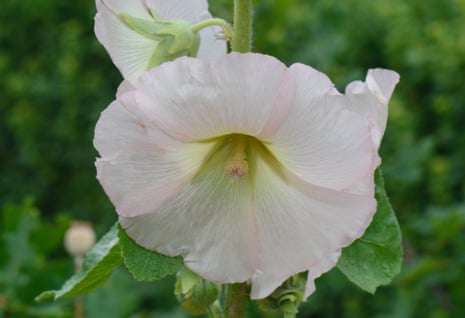Top Stories
Autumn’s Arrival: Hollyhocks Thrive in Changing Weather

The first storm of autumn has arrived, and the hollyhocks in the garden stand tall, their robust stems bending but not breaking. Reaching heights of over 10 feet, these resilient plants have flourished since spring, offering beauty and sustenance to a variety of garden wildlife. Despite their weathered appearance, with some leaves shriveling, they continue to provide vertical interest and a habitat for local insects.
During the summer holidays, these hollyhocks became a playground for grandchildren, who ran joyfully beneath their grand canopies. The blooms attracted a range of pollinators, including red admirals and peacock butterflies, while bumblebees busily gathered nectar from the large, trumpet-shaped flowers. These single-flowered varieties, known scientifically as Alc ea rosea, are particularly beneficial for insects, as they produce plenty of nectar and pollen compared to more complex double-flowered types.
Pollination is a delicate process for these plants. The hollyhocks feature a central structure with anthers and stigmas that mature at different times, ensuring cross-pollination occurs. This strategy enhances genetic diversity, vital for the plants’ long-term survival. As autumn sets in, the seeds have matured, and the gardener has opted to allow some of the plants to go to seed, letting them settle where they please. Remarkably, one hollyhock has managed to lift a heavy stone paving slab as it grew, demonstrating the plant’s vigorous nature.
Despite the beauty of the hollyhocks, they have not been without challenges. The plants developed rust disease, prompting the gardener to prune the leaves to improve air circulation without the use of chemical fungicides. Now, as October unfolds, the seeds are ready for harvest. Each seed case, encased in five sepals, resembles a small parcel, reminiscent of dim sum. When the tops of these cases relax, they reveal a neat stack of seeds, resembling coins.
The gardener plans to share the seeds with friends keen to cultivate them in their own gardens. Although some blooms remain, their petals have taken on a brownish hue, yet they still protect the valuable pollen within.
On this particular October day, the atmosphere is alive with sounds of nature. A heron calls as it flies overhead, while jackdaws chatter excitedly in the gusty winds. These moments capture the essence of autumn: the transition into cooler weather, the onset of frost, and the joy of seed collecting.
As the season progresses, the hollyhocks, despite their challenges, continue to offer a vibrant display and support local wildlife, marking a successful year in the garden. The story of these hollyhocks is a testament to resilience and the beauty of nature’s cycles, reminding us of the simple joys found in our gardens.
For those interested in exploring more about nature’s intricacies, “Under the Changing Skies: The Best of the Guardian’s Country Diary, 2018-2024” published by Guardian Faber provides insightful reflections and observations.
-

 Health2 months ago
Health2 months agoFiona Phillips’ Husband Shares Heartfelt Update on Her Alzheimer’s Journey
-

 Health1 month ago
Health1 month agoNeurologist Warns Excessive Use of Supplements Can Harm Brain
-

 World1 month ago
World1 month agoCole Palmer’s Cryptic Message to Kobbie Mainoo Following Loan Talks
-

 Entertainment3 months ago
Entertainment3 months agoLove Island Star Toni Laite’s Mother Expresses Disappointment Over Coupling Decision
-

 Entertainment2 months ago
Entertainment2 months agoMajor Cast Changes at Coronation Street: Exits and Returns in 2025
-

 Entertainment2 months ago
Entertainment2 months agoMasterChef Faces Turmoil as Tom Kerridge Withdraws from Hosting Deal
-

 World3 weeks ago
World3 weeks agoMassive Sinkhole Opens in Bangkok, Swallowing Cars and Causing Chaos
-

 World3 weeks ago
World3 weeks agoMichelle Tsiakkas Opens Up About Jamie Borthwick Before BBC Exit
-

 Lifestyle2 months ago
Lifestyle2 months agoEngland Flags Spark Controversy This Summer: A Cultural Debate
-

 Entertainment3 months ago
Entertainment3 months agoWoman Transforms Life with Boot Camp, Losing Nearly 9 Pounds in a Week
-

 World2 months ago
World2 months agoCoronation Street’s Asha Alahan Faces Heartbreaking Assault
-

 Entertainment3 months ago
Entertainment3 months agoColeen Nolan Reflects on Family Tragedy and Reconciliation









